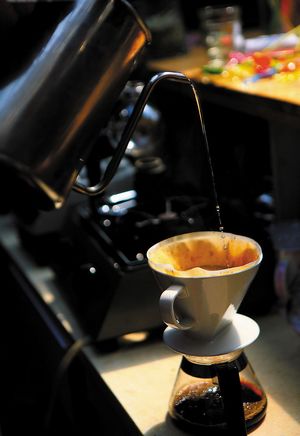From model to champion of WLAC Coffee pull Art Competition in China
Follow the caf é (Wechat official account vdailycom) and found that Beautiful Cafe opened a small shop of its own.
Li Qi, champion barista of Mellon, intermediate trainer of Mellon training Department, engaged in coffee industry for 3 years.

Competition experience:
In 2014, he was certified by SCAE as a barista.
China final champion of the 2016 WLAC World pull Flower Art Competition
The runner-up of the 2016 WLAC World pull Flower Art Competition
As a representative of Mellon Coffee's cutting-edge baristas, she entered the coffee industry in the early winter of 2013. She got this amazing resume in three years. In addition to her daily efforts, she also had to recognize Li Qi's superhuman talent in the coffee field.
Neatness and neatness are the characteristics of Li Qi's coffee. She believes that to make a good cup of coffee, not only in the coffee itself, but in any details before the coffee into the cup must be meticulous. Honor was added and praised constantly, but she only faced it with a normal heart. 'The Chinese barista industry is on the rise, and soon more good baristas will emerge one after another, 'she said. So even if she won the championship, she was not proud, and the most common sight every day was still her diligent practice in the Mellon Cafe. She hopes to work with more baristas to promote the spread of Chinese boutique coffee culture in the future.
[related reading]
The grading of coffee
If the owner of two cafes is discussing, owner A says, "the coffee beans we use in our shop are NO.2 in Santos, Brazil. What about your store?" owner B said, "We use Brazilian NO.1 of the same grade as Blue Mountain NO.1."
The evaluation method adopted in Brazil is the "deduction method", which is classified according to the number of defective beans per 300g of staple beans, with a total of seven grades from NO.2 to No.8, and a deduction of less than 4 is classified as NO.2 (NO.8 deduction is 360). What does not have a single defective bean can of course be called NO.1, but this situation is so rare that a certain supply cannot be maintained, so Brazil sets NO.2 as the highest level, not NO.1. From this, we know that shopkeeper B is pretending to be a forced offender.
Coffee-producing countries have their own grading methods and quality evaluation criteria in order to grade their harvested coffee (there are also countries that do not have a unified export specification, like Yemen, which produces the famous coffee mocha Matali). If the common evaluation criteria of coffee producing countries around the world, it would be much more convenient for buyers, but unfortunately, the current classification criteria are still based on the national conditions of each producing country.
Having said that, we can still roughly distinguish according to the following three points.
(1) grading according to the altitude of the place of origin
(2) grading according to the sieve (size of raw beans)
(3) grading according to the proportion of screen and defective beans.
1. Evaluate the quality by the altitude of the producing area
As mentioned earlier, the quality of high real estate coffee is better than that of low real estate, so the height of origin is also included in one of the quality evaluation criteria. The higher the altitude and the lower the relative temperature, the coffee fruit can ripen slowly, so the fully ripe beans have good expansibility and are easy to bake. As a result, coffee-producing countries in Central America evaluate the quality of coffee beans almost exclusively by the altitude of their origin.
For example, coffee from Guatemala, the highest quality coffee in the country, is called SHB, an acronym for Strictly Hard Bean, and is grown at an altitude of more than 1350 meters. The same is true of Mexico, where the highest quality SHG (Strictly Hard Grown) is grown in highlands above 1700 meters above sea level. SHG in El Salvador and Honduras is also grown in highlands above 1200 meters above sea level.
If coffee is planted on a flat plateau like Brazil, it can be mechanized on a large scale, but the main cultivation areas of coffee in China and the United States are on the slopes of hills, so it is difficult to use mechanized farming. It is said that there are even dangerous slopes with a slope of more than 40 degrees in the Blue Mountain area of Jamaica.
Planted in that place, ripe and red fruits can only be picked carefully by hand. Although the cost is high, high-quality coffee with few impurities and defective beans can be produced.
Quality and grading of Guatemalan coffee beans
two。 Evaluate the quality by sieve
Countries that use sieves to evaluate quality include Kenya, Tanzania, Colombia and other Colombian producers of fresh and bright coffee (one of the types of coffee traded on the New York Futures Exchange based on origin). The so-called judging quality according to the screen means to evaluate the quality according to the size of raw beans. For all kinds of raw beans, the size of the beans is determined by a perforated iron plate screen.
The size of the hole in the sieve is 1 canopy 64 inches, so the 17 sieve refers to 17 canopy 64 inches, which means that the raw bean can pass through the sieve with a hole diameter of 6.75 mm. Beans larger than this size cannot pass through the sieve, and small ones can pass through, so the larger the number of the sieve, the bigger the particles of the beans.
The finest coffee beans in Tanzania are large granulated beans called AA, which need a sieve of more than 18 millimeters, while AA in Kenya also uses large granulated beans with holes above 7.2mm. Colombia has two grades: Supremo and Excelso. The special grade needs a sieve of more than 17, and the upper grade needs a sieve of 14 and 16 (refers to the beans with sieve 16 mixed with 11% of 14 sieve beans).
Large granulated beans are more varied in taste than small ones. Depending on the size of the screen, the beans sifted do make a difference in taste.
3. Evaluate the quality according to the proportion of screen and defective beans.
Then there is Brazil, a big coffee country, which uses three grading methods: defective bean proportion (deduction method), sieve mesh, and taste test, to derive the third evaluation method. For example, when you buy Brazilian coffee beans, you will see the sign "Brazil Santos NO.2,19 sieve, very mild (Strictly Soft)", which is described as follows:
Brazil-name of the producing country
Santos-export port
NO.2-- represents the grading of the number of defective beans mixed in, NO.2 is the highest grade, and NO.8 is the lowest limit of output sales specifications.
Sieve No. 19-indicates the size of the beans. Brazil means 12-20. The larger the number, the bigger the particles. 19 represents beans that pass through a 7.54 mm hole sieve. However, this grading method is limited to flat beans, and round beans should be graded with a special oval mesh (8-13).
Extremely mild-indicates the grading of Cup Testing, and extremely mild means the highest level.
Brazilian cup test classification method:
Grade 1:Strictly Soft (very mild)
Grade 2:Soft (mild)
Grade 3:Softish (slightly mild)
Level 4:Hard (difficult)
Grade 5:Rio (light iodine flavor)
Grade 6:Rioy (strong iodine flavor)
The grade 1-3 here is collectively referred to as "mild", with a balance of sweetness, bitterness and sour taste. On the contrary, grades 5 and 6 are inferior products with iodine odor. The soil around Rio de Janeiro in Brazil has a strong smell of iodine, and when the coffee fruit falls on the soil, it will be stained with a unique flavor.
Brazil's three-stage classification system has not been adopted in other countries because it is not necessary. In other words, even if you don't need a cup test, you can know that these coffees have a certain quality. Brazil adopts this "cup test grading method" because the production area is too large and produces too many beans, and these coffee beans are often mixed in order to make the special coffee flavor for export, so it is necessary to use "cup test" classification in the case of different quality.
For this reason, coffee appraisers in Brazil must comply with strict requirements: in order to fully operate their sense of taste and smell when identifying coffee, they should not eat leeks, onions, garlic and other foods that paralyze their tongues in addition to tooth decay. Tobacco, alcohol and strong perfumes are also prohibited. There are often stone pillars in front of the Zen temple that "meat and wine are prohibited from entering the mountain gate". The "meat wine" here refers to leeks, green onions and other strong flavor of green vegetables and wine. Caffeine appraisers in Brazil, like Zen monks, are vegetarian every day.
In addition to the three classifications mentioned above, cultivated land classification is used in some areas, like Jamaica.
There are different ways of grading in different producing countries, and it takes a little skill to remember them all, but it's no big deal after you get familiar with it. In a word, "large granulated coffee beans are good beans in the highlands without defective beans."
Quality and grading of Brazilian coffee beans (deduct points according to the amount of defective beans and impurities mixed in every 300g coffee beans, and then divide the beans into NO.1~NO.8 depending on the deduction)
Important Notice :
前街咖啡 FrontStreet Coffee has moved to new addredd:
FrontStreet Coffee Address: 315,Donghua East Road,GuangZhou
Tel:020 38364473
- Prev

Listen to Starbucks baristas tell the story of coffee
Following Cafe (official Wechat account vdailycom) found that Beautiful Cafe opened a small shop of its own. When you bring a cup of warm coffee to your mouth, a coffee experience for you officially begins. A cup of coffee that has been refined and condensed into essence will bring you more than just the enjoyment of taste. What's more, it is a process of multi-sensory cooperative evaluation. Starbucks.
- Next

Barista novice must know: a guide to the selection of coffee pots
Follow the caf é (Wechat official account vdailycom) found that the coffee maker is a coffee-making utensil opened in Beautiful Cafe. It was produced in 1685 and became popular during Louis XV. With the continuous development of coffee, there are many kinds of coffee pots. The principle of coffee extraction from each coffee pot is different, and the taste of coffee is also very different. Today, we're going to learn
Related
- What is the meaning of lactic acid fermentation with coffee bean treatment?
- How to judge the state of foam by sound?
- How does the latte pull out the unicorn pattern? Come to get for a little trick to improve the flower pull!
- Will flower pulling affect the taste of the latte?
- Do you know the history of coffee?
- The difference between honey treatment and sun washing what is raisin honey treatment?
- What kind of milk can a novice use to make coffee foam to keep the foam longer? The correct method and skills of milking tutorial sharing
- Why do washed coffee beans taste sour? Flavor characteristics of washed Coffee
- Introduction to the skill of how to practice the size and height of water injection around the circle of hand-brewed coffee
- How do beginners practice coffee flower drawing from scratch?

